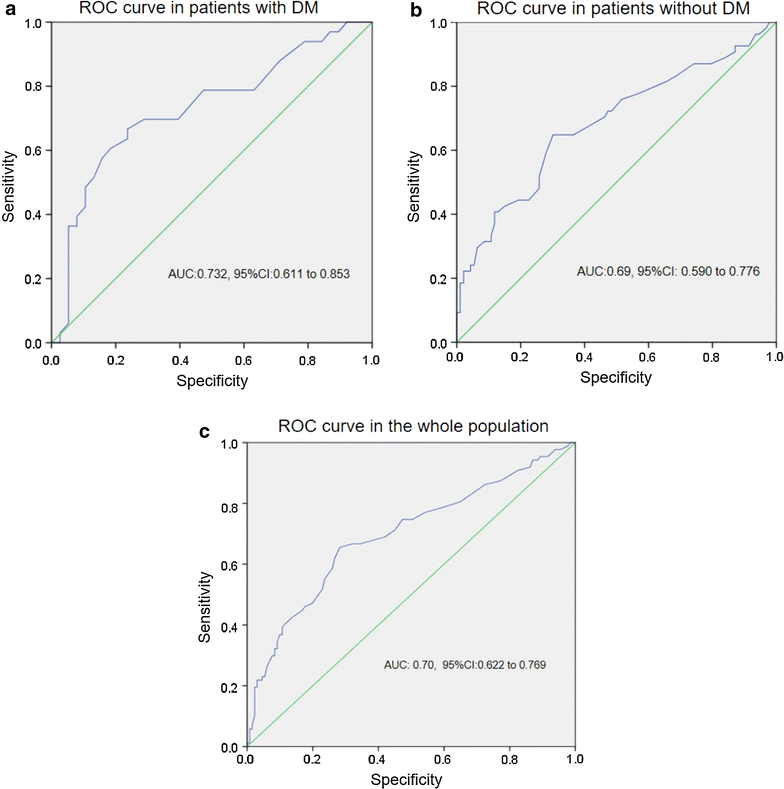Red blood cell distribution width as a prognostic marker in patients with heart failure and diabetes mellitus
- PMID: 28683798
- PMCID: PMC5501451
- DOI: 10.1186/s12933-017-0563-1
Red blood cell distribution width as a prognostic marker in patients with heart failure and diabetes mellitus
Abstract
Background: Red blood cell distribution width (RDW) is an established prognostic marker in acute and chronic heart failure (HF). Recent studies have pointed out a link among RDW, diabetes mellitus (DM) and inflammation. We sought to investigate the prognostic value and longitudinal pattern of RDW in patients with concomitant HF and DM, which remains unknown.
Methods: A total of 218 patients (71 diabetics) who presented with acute HF had RDW measured at admission, discharge and 4, 8 and 12 months post-discharge. The study endpoint was all-cause mortality or rehospitalization for HF during 1-year follow-up.
Results: The study endpoint was met in 33 patients (46.5%) with DM and in 54 patients (36.7%) without DM. RDW at admission was associated with higher event rate both in HF patients with and without DM (adjusted HR: 1.349, p = 0.002, 95% CI 1.120-1.624 and adjusted HR: 1.142, p = 0.033, 95% CI 1.011-1.291 respectively). In addition, a significant interaction was found between diabetes and RDW longitudinal changes (βinteraction = -0.002; SE = 0.001; p = 0.042).
Conclusions: Despite the similar prognostic significance of RDW in diabetic and non-diabetic HF patients regarding the study endpoint, longitudinal changes were found to be significantly different between these two groups of HF patients. This might be due to the higher inflammatory burden that diabetic HF patients carry and may provide new insights to the pathophysiological mechanism of RDW increase in HF, which remains unknown.
Keywords: Diabetes mellitus; Heart failure; Prognosis; RDW.
Figures


Similar articles
-
Prognostic significance of red cell distribution width and other red cell parameters in patients with chronic heart failure during two years of follow-up.Kardiol Pol. 2016;74(7):657-64. doi: 10.5603/KP.a2016.0004. Epub 2016 Jan 18. Kardiol Pol. 2016. PMID: 26779853
-
Red blood cell distribution width is a significant prognostic marker in advanced heart failure, independent of hemoglobin levels.Hellenic J Cardiol. 2014 Nov-Dec;55(6):457-61. Hellenic J Cardiol. 2014. PMID: 25432197
-
Red blood cell distribution width predicts new-onset anemia in heart failure patients.Int J Cardiol. 2012 Oct 18;160(3):196-200. doi: 10.1016/j.ijcard.2011.04.018. Epub 2011 May 8. Int J Cardiol. 2012. PMID: 21555160
-
Red Blood Cell Distribution Width is a Biomarker of Red Cell Dysfunction Associated with High Systemic Inflammation and a Prognostic Marker in Heart Failure and Cardiovascular Disease: A Potential Predictor of Atrial Fibrillation Recurrence.High Blood Press Cardiovasc Prev. 2024 Sep;31(5):437-449. doi: 10.1007/s40292-024-00662-0. Epub 2024 Jul 20. High Blood Press Cardiovasc Prev. 2024. PMID: 39031283 Review.
-
Red Blood Cell Distribution Width in Heart Failure: Pathophysiology, Prognostic Role, Controversies and Dilemmas.J Clin Med. 2022 Mar 31;11(7):1951. doi: 10.3390/jcm11071951. J Clin Med. 2022. PMID: 35407558 Free PMC article. Review.
Cited by
-
Application of neutrophil-lymphocyte ratio and red blood cell distribution width in diabetes mellitus complicated with heart failure.World J Diabetes. 2024 Jun 15;15(6):1226-1233. doi: 10.4239/wjd.v15.i6.1226. World J Diabetes. 2024. PMID: 38983818 Free PMC article.
-
The predictive values of admission characteristics for 28-day all-cause mortality in septic patients with diabetes mellitus: a study from the MIMIC database.Front Endocrinol (Lausanne). 2023 Aug 1;14:1237866. doi: 10.3389/fendo.2023.1237866. eCollection 2023. Front Endocrinol (Lausanne). 2023. PMID: 37608790 Free PMC article.
-
Predictive Value of Red Blood Cell Distribution Width for 1-Year All-Cause Mortality in Critically Ill Patients with Acute Myocardial Infarction.Int J Gen Med. 2022 Jan 11;15:465-471. doi: 10.2147/IJGM.S345109. eCollection 2022. Int J Gen Med. 2022. PMID: 35046707 Free PMC article.
-
Association of RDW, NLR, and PLR with Atrial Fibrillation in Critical Care Patients: A Retrospective Study Based on Propensity Score Matching.Dis Markers. 2022 May 27;2022:2694499. doi: 10.1155/2022/2694499. eCollection 2022. Dis Markers. 2022. PMID: 35669502 Free PMC article.
-
Red Cell Distribution Width and Patient Outcome in Cardiovascular Disease: A ''Real-World'' Analysis.J Cardiovasc Dev Dis. 2021 Sep 26;8(10):120. doi: 10.3390/jcdd8100120. J Cardiovasc Dev Dis. 2021. PMID: 34677189 Free PMC article.
References
-
- Morris M, Davey F. Basic examination of blood. In: Henry JB, editor. Henry’s clinical diagnosis and management by laboratory methods. 20. Philadelphia: Saunders; 2001.
MeSH terms
LinkOut - more resources
Full Text Sources
Other Literature Sources
Medical
Research Materials
Miscellaneous

